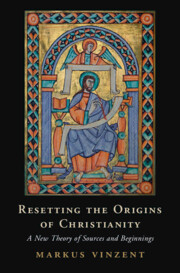Refine search
Actions for selected content:
23990 results in Ancient history

Resetting the Origins of Christianity
- A New Theory of Sources and Beginnings
-
- Published online:
- 30 December 2022
- Print publication:
- 12 January 2023
5 - Laypeople and Property
- from Part II - The Laity
-
- Book:
- Beyond the Monastery Walls
- Published online:
- 09 December 2022
- Print publication:
- 29 December 2022, pp 151-175
-
- Chapter
- Export citation
2 - The Manuscript
- from Part I - The Gate
-
- Book:
- Beyond the Monastery Walls
- Published online:
- 09 December 2022
- Print publication:
- 29 December 2022, pp 38-79
-
- Chapter
- Export citation
Figures
-
- Book:
- Beyond the Monastery Walls
- Published online:
- 09 December 2022
- Print publication:
- 29 December 2022, pp ix-ix
-
- Chapter
- Export citation
7 - Conflict and Justice
- from Part II - The Laity
-
- Book:
- Beyond the Monastery Walls
- Published online:
- 09 December 2022
- Print publication:
- 29 December 2022, pp 216-251
-
- Chapter
- Export citation
4 - Laypeople and Documents
- from Part II - The Laity
-
- Book:
- Beyond the Monastery Walls
- Published online:
- 09 December 2022
- Print publication:
- 29 December 2022, pp 121-150
-
- Chapter
- Export citation
Dedication
-
- Book:
- Beyond the Monastery Walls
- Published online:
- 09 December 2022
- Print publication:
- 29 December 2022, pp v-vi
-
- Chapter
- Export citation
Part I - The Gate
-
- Book:
- Beyond the Monastery Walls
- Published online:
- 09 December 2022
- Print publication:
- 29 December 2022, pp 1-118
-
- Chapter
- Export citation
10 - Conclusions
- from Part II - The Laity
-
- Book:
- Beyond the Monastery Walls
- Published online:
- 09 December 2022
- Print publication:
- 29 December 2022, pp 321-355
-
- Chapter
- Export citation
1 - Introduction
- from Part I - The Gate
-
- Book:
- Beyond the Monastery Walls
- Published online:
- 09 December 2022
- Print publication:
- 29 December 2022, pp 3-37
-
- Chapter
- Export citation
8 - Power, Personal Relationships, and Letters
- from Part II - The Laity
-
- Book:
- Beyond the Monastery Walls
- Published online:
- 09 December 2022
- Print publication:
- 29 December 2022, pp 252-283
-
- Chapter
- Export citation
3 - Language, Anachronism, and the Laity
- from Part I - The Gate
-
- Book:
- Beyond the Monastery Walls
- Published online:
- 09 December 2022
- Print publication:
- 29 December 2022, pp 80-118
-
- Chapter
- Export citation
6 - Family
- from Part II - The Laity
-
- Book:
- Beyond the Monastery Walls
- Published online:
- 09 December 2022
- Print publication:
- 29 December 2022, pp 176-215
-
- Chapter
- Export citation
Contents
-
- Book:
- Beyond the Monastery Walls
- Published online:
- 09 December 2022
- Print publication:
- 29 December 2022, pp vii-viii
-
- Chapter
- Export citation
Manuscript Index
-
- Book:
- Beyond the Monastery Walls
- Published online:
- 09 December 2022
- Print publication:
- 29 December 2022, pp 377-377
-
- Chapter
- Export citation
Acknowledgments
-
- Book:
- Beyond the Monastery Walls
- Published online:
- 09 December 2022
- Print publication:
- 29 December 2022, pp x-xi
-
- Chapter
- Export citation
Bibliography
-
- Book:
- Beyond the Monastery Walls
- Published online:
- 09 December 2022
- Print publication:
- 29 December 2022, pp 356-376
-
- Chapter
- Export citation
Part II - The Laity
-
- Book:
- Beyond the Monastery Walls
- Published online:
- 09 December 2022
- Print publication:
- 29 December 2022, pp 119-355
-
- Chapter
- Export citation
Copyright page
-
- Book:
- Beyond the Monastery Walls
- Published online:
- 09 December 2022
- Print publication:
- 29 December 2022, pp iv-iv
-
- Chapter
- Export citation
9 - Freedom and Unfreedom
- from Part II - The Laity
-
- Book:
- Beyond the Monastery Walls
- Published online:
- 09 December 2022
- Print publication:
- 29 December 2022, pp 284-320
-
- Chapter
- Export citation
